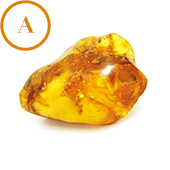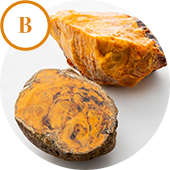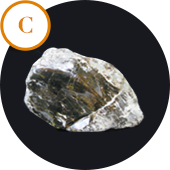Amber is a "resin fossil," so to speak, which is made from the resin of pine trees, cedar trees, cypress trees, etc., buried under sediment or the ocean floor and chemically altered by exposure to high temperatures and pressures over a period of tens to hundreds of millions of years. Amber is widely mined in Asia, Europe, Central and South America, and other parts of the world. The world's three major types of amber are Kuji amber from Kuji City in Iwate Prefecture, Japan; Dominican amber from the Dominican Republic in Central America; and Baltic amber from Russia, Poland, Germany, Denmark, Estonia, and other regions around the Baltic Sea. Kuji and Dominican amber are mined from very old strata, approximately 99 million years old, while Baltic amber is mined from strata approximately 30 to 50 million years old.
The world's three largest producers of amber
Baltic amber
It is said to have about two-thirds of the world's reserves, making it the world's largest producer.
tree species The most popular theory is that it is a member of the Araucaria (Nanyosugi) family.
variety Often beer color, milky yellow, white, etc.
Kuji Amber
It is older than the other major production areas.
tree species Araucaria (Nanjohsgi).
variety Often reddish brown, striped, black, etc.
Dominican Republic Amber
Because of its young age and origin in tropical forests. Tree species: Hymenaea
tree species A member of the Hymenaea family
variety Pale amethyst and other colors are common, blue and green are also seen.
We at Amber Biotechnology have a laboratory in Kuji in cooperation with Iwate University. The color and pattern of amber varies depending on the topography and environment of the region where it is produced, as well as the species and age of the plants from which it is derived. The Kuji amber produced from the resin of coniferous trees of the cedar family is characterized by a variety of colors and patterns, including light yellow and candy yellow, reddish brown, almost black, and striped patterns. Amber, which has the property of burning, has been burned as incense in Japan since the Heian period (794-1192), and in Kuji, amber was called "kununrokko.
Dominican amber is mainly made from the resin of hardwoods of the Fabaceae family, and its color ranges from light candy to dark yellow and orange, with some amber appearing greenish when held up to the sun. Another characteristic of amber from this region is the abundance of "insect-insect amber," in which insects are trapped.
Baltic amber, which is said to account for 75-801 TP3T of the world's amber production, is made from the resin of an extinct coniferous tree of the Pinaceae family, and has a unique variation of colors, from candy like brandy or whiskey to creamy yellow or milky white.
Amber's Potential for Health, Beauty, and Longevity Part 1
In Europe, it has been used since ancient times.
Serves as a household staple
In Russia and Scandinavia, amber is loved as a "healing gemstone" and has been used as a medicine for wounds and as a fever reducer since ancient times.natural medicine*1 Amber has been popular as an herbal remedy for colds, hangovers, and fatigue since the Middle Ages in Europe. Since medieval Europe, amber has also been used like an herbal medicine, crushed and drunk to take care of colds, hangovers, and fatigue. As time progressed a bit further into the 19th century, amber was empirically recognized around the Baltic Sea as being useful for normalizing the autonomic nervous system and hormonal balance, and it was common practice to wear an amber necklace if you suffered from Graves' disease, a type of thyroid disorder. However, the clear effects and benefits remained a mystery for a long time, and it was not until 1956, when German metallurgist Gergius Agricola succeeded in extracting succinic acid, that many scientists finally began to treat "amber" as a research material.
*1 It is not yet approved as a drug in Japan at this time. In addition, there is no treatment by a physician in Japan.
Amber's Potential for Health, Beauty, and Longevity Part 2
Baltic amber.
Russian sanatoriums with abundant use of
In 1980, the "Amber Coast" sanatorium was established in Kaliningrad, Russia, as a full-fledged therapeutic amber sanatorium. Today, amber therapy for the purpose of treatment and healing is still conducted at the facility, which is accredited by the Russian government. The facility also has a laboratory where various basic research and analysis of amber is conducted. The amber therapy room, which was realized with the cooperation of a local amber mining company, is equipped with an "amber path" covered with amber and an "amber cabinet" whose floor and walls are covered with amber. In addition, various amber therapies, such as massages using amber discs, have been proven to speed up the healing of wounds, relieve symptoms of high blood pressure, and relieve nervous tension by introducing succinic acid through the skin or by exposing the skin to large amounts of negative ions generated by the amber. Amber has been used to heal wounds faster, relieve high blood pressure, and ease nervous tension.

Amber's Potential for Health, Beauty, and Longevity Part 3
Prevents corrosion of inclusions
Mystical power to achieve long-term preservation
In 1980, the "Amber Coast" sanatorium was established in Kaliningrad, Russia, as a full-fledged therapeutic amber sanatorium. Today, amber therapy for the purpose of treatment and healing is still conducted at the facility, which is accredited by the Russian government. The facility also has a laboratory where various basic research and analysis of amber is conducted. The amber therapy room, which was realized with the cooperation of a local amber mining company, is equipped with an "amber path" covered with amber and an "amber cabinet" whose floor and walls are covered with amber. In addition, various amber therapies, such as massages using amber discs, have been proven to speed up the healing of wounds, relieve symptoms of high blood pressure, and relieve nervous tension by introducing succinic acid through the skin or by exposing the skin to large amounts of negative ions generated by the amber. Amber has been used to heal wounds faster, relieve high blood pressure, and ease nervous tension.















